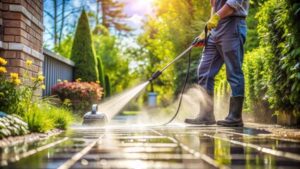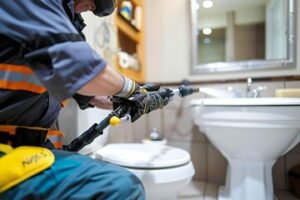Unlike a mop or brush, a pressure washer can dislodge deeply ingrained dirt and mildew, making cleaning faster and easier. This can also lengthen the lifespan of exterior paint and other materials.

Always use caution when pressure washing, as too much water or heat can damage surfaces. A professional service can assess the surface and determine the correct PSI and nozzle for optimal results. Visit Website to learn more.
Pressure washing can remove dirt, mildew and other organic growth from various surfaces. It can also help to eliminate the odors caused by these growths, which are often accompanied by allergens and irritants. The key to effective cleaning is choosing the right PSI setting for each surface. This is determined by the amount of water pressure generated and the flow rate (in gallons per minute or GPM). A lower PSI is needed for delicate surfaces such as wood or soft stone, while a higher PSI is ideal for most commercial and residential structures.
The power of pressure washing can remove dirt, mud, grime, loose paint, mold, mildew, oily stains, salt, moss, gum, tree sap and other contaminants from asphalt, concrete, brick and siding surfaces, as well as outdoor furniture, vehicles, and building facades. It can even get rid of weeds and control their spread. However, it is important to choose the right settings and use caution when using this equipment. Overuse can damage or degrade surfaces and may even cause injury.
Regular maintenance with a professional pressure washer is an efficient and cost-effective way to maintain your home or business. In addition to enhancing curb appeal, it can help prolong the life of your siding, roof, decks and driveways by removing buildup and preventing premature deterioration.
Mildew and mold growths not only detract from the appearance of your property, but they can also pose health hazards. They can aggravate allergies, trigger asthma attacks and exacerbate existing health conditions. They can also eat away at the surface of your home, weakening its foundation and possibly causing long-term damage.
Regularly scheduled professional pressure washing removes unsightly green mold and mildew stains from exterior surfaces and restores their natural beauty and safety. It can also help to protect your health by removing harmful mold spores before they become a problem and preventing them from returning. It can also revitalize the look of weathered or dull paint, extending its lifespan.
Preventing Stains
Pressure washing regularly can help prevent stains from developing on your property. Stains are more than just unsightly; they can cause damage as well. Over time, stains can cause the paint on your house or other surfaces to fade and chip, which can expose the underlying materials and cause deterioration. Additionally, mold, mildew, moss and algae can also grow and cause structural damage over time. Using pressure washing, these growths can be easily removed and prevented from returning.
In addition to enhancing your property’s appearance, regular pressure washing can improve its value as well. A clean home or business often looks more inviting and hospitable, which can boost its appeal and attract potential buyers. In commercial properties, a clean parking lot, entranceway, loading dock or dumpster area can greatly improve employee and customer satisfaction as well as the property’s overall image.
Choosing the right cleaning solutions and equipment is also essential. Look for a company that uses biodegradable detergents that break down naturally, so they don’t leave behind any harmful chemicals. You’ll also want to choose a service provider that has experience in the field and knows how to properly use the different types of pressure washers, ensuring that your property is not damaged during the cleaning process.
Pre-treating concrete surfaces before pressure washing is another way to improve the quality of your cleaning results and avoid damage. Using special pre-treatment solutions that loosen and emulsify tough dirt, grime, oil, and stains can make the cleaning process much easier and more effective. These pre-treatment solutions can be purchased from most hardware stores or home improvement centers.
While pressure washing is a great tool for maintaining and improving the appearance of your residential or commercial property, it can be dangerous when used incorrectly. Inexperienced individuals may over-use the pressure washer or use inappropriate cleaning products and water pressure, causing damage to the surface of your building. Choosing a professional service that has the proper equipment and expertise can save you time and money in the long run. They will know the proper psi, water rotation and cleaning products to use for your specific needs, removing stubborn and persistent stains with ease while protecting the integrity of your surfaces.
Enhancing the Appearance of Your Property
Pressure washing transforms the look of residential and commercial properties. It removes dirt, mildew, and other unsightly elements that dull the surfaces of buildings and create a less-than-pleasant first impression. A clean building is inviting and gives the appearance that it is well-cared for and maintained, which can boost its value in the real estate market. It also protects against damage to the facade, which can result in costly repairs.
Over time, mold, mildew, and algae can cause long-term damage to building materials. Regularly pressure washing these surfaces protects them from these damaging agents and extends their lifespan, saving property owners money in the long run. Pressure washing can also eliminate odors, which can be problematic for those with respiratory issues.
For businesses, a clean exterior promotes a positive image and creates a good first impression for customers and guests. In addition, it protects the integrity of the building and reduces health risks for occupants by eliminating contaminants like mildew and mold.
Moss, dirt, and other growths can make wood decks and patios unsafe for family and friends to walk on, but a thorough pressure wash can restore these areas to their original state and make them safe for use again. Pressure washing can even remove unsightly stains caused by bird droppings, paint, or graffiti, giving the building a more professional and attractive look.
Whether you are looking to sell your home or simply want to enjoy it in better condition, pressure washing is an affordable way to enhance its curb appeal and protect your investment. From walkways and driveways to siding and roofs, we offer high-quality pressure washing services that can make your property look like new again. Contact us today to learn more about our services or to schedule an appointment for your home or business. We are proud to serve clients throughout the Phoenix Metro area. We are committed to delivering excellent customer service and a quality product at an affordable price. We look forward to hearing from you!
Preventing Damage
Pressure washing is a crucial part of property preservation. Surfaces like driveways, roofs, patios, and siding are constantly exposed to dirt, mildew, mold, and debris that can degrade them over time. These contaminants can cause discoloration, trap moisture, and lead to structural damage. Regular pressure washing helps to prevent these issues by removing them before they can spread and cause further damage.
Professionals know the correct psi, water rotation, cleaning solutions, and surface-specific techniques for safe and effective cleaning. Improper use of a pressure washer can be damaging to your home or business, leading to costly repairs and replacements. Professionals also have access to higher-powered equipment that can safely clean surfaces and structures, preventing damage even on the most stubborn stains.
Prevents Mold, Mildew, and Algae
Dirt, grime, algae, and other substances can wreak havoc on your property over time. They can stain and discolor surfaces, create slippery spots, and trap moisture, resulting in premature wear and potentially structural damage. A simple cleaning with a high-pressure washer can remove these substances and prevent them from returning, keeping your surfaces in top condition and maintaining their value over time.
Improves Indoor Air Quality
The same pollutants that deteriorate your property’s surfaces can also impact indoor air quality. When left unattended, they can trigger allergies and respiratory issues. By removing these substances with pressure washing, you can create a healthier environment for your family or employees.
Preparing for a Painting Project
If you’re planning on painting your house or a commercial building, a fresh coat of paint can make a huge difference in its appearance and help protect the structure from moisture damage. However, you can’t just slap the paint on over a dirty surface, so a thorough pressure wash is essential before beginning any renovation projects. A pressurized wash can lift dirt, grime, and moss, as well as old or peeling paint, leaving you with a smooth surface to work on.
A clean, well-maintained property is a great way to enhance curb appeal and attract potential customers. Whether you’re looking to sell your home or want to boost the image of your business, professional pressure washing is an affordable and easy way to make your space look its best.


